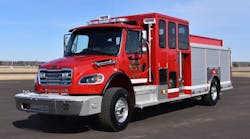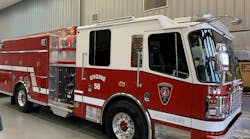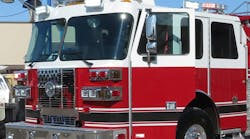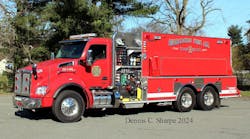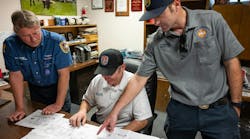First, a little history regarding power-operated aerial ladder apparatus is appropriate. The first hydraulic, all-metal aerial ladder truck was a three-section, 100-foot, tractor-drawn aerial produced by Peter Pirsch for the Melrose, MA, Fire Department in 1935. Prior to this date, most aerial ladder units were constructed of laminated wood sections consisting of a base section with a single fly section and were raised by a mechanical spring-loaded device. Following this design built by Peter Pirsch, other prominent builders of the day - Seagrave, American La France and Maxim - introduced their own hydraulic-powered steel aerial ladders ranging in length from 65 feet to 85 feet.
This ladder design, however, was slow to gain acceptance with major fire departments such as Boston, Chicago and the FDNY. New York placed its first hydraulic-powered aerial ladder in service in 1948, when it took delivery of a Seagrave 85-foot tractor-drawn aerial and was assigned to Ladder Company 110. FDNY continued to specify wooden aerial ladders through 1955, when it accepted delivery of 25 FWD 75-foot tractor-drawn aerials. Gradually, after this point in time, FDNY and other major fire departments slowly began to accept the metal aerial device, although the last wooden aerial ladder was not officially retired from the FDNY fleet until June 1973, some 38 years after Peter Pirsch had built its first powered ladder truck.
More recent advancements in aerial design can be traced to the development of the Snorkel articulating boom and the telescopic boom platform during the early 1960s. These devices were introduced into the fire service at a time when many cities were experiencing heavy fire conditions and the ability of both snorkels and tower ladder units to deploy elevated master streams with pinpoint accuracy greatly enhanced the ability of fire departments to control these major incidents. Another significant benefit of platform aerial devices is the enhanced safety characteristics of these units, which let firefighters work within the confines of the platform to perform rescue, exterior ventilation and overhaul.
One of the most significant developments in aerial ladder design occurred in 1991, when the National Fire Protection Association (NFPA) 1901 standard was introduced to require that aerial ladders be capable of operating in any position that the ladder would reach while supporting a minimum tip load of 250 pounds. The older-design units had proven to be very reliable when operated at relatively steep angles of elevation; however, they had not been designed to operate at full extension at low angles of elevation, which created conditions for aerial ladders to have catastrophic collapses. In addition, these ladders generally were limited in their ability to resist lateral forces.
All of these design and safety enhancements made the newer aerial ladder devices superior to their pre-1991 counterparts; however, the trade off was additional weight and size of the ladder sections that would require heavier chassis and tandem axles to carry the loads. The size of this new generation of aerial device has created driving problems as well as placement problems. Another trade off was the introduction of safety devices that actually made some aerial devices much harder to place and operate in a timely fashion. Some departments that operated smaller aerial units found that they were unable to purchase a replacement aerial ladder truck that would fit into older stations or had difficulty in maneuvering around in their first-due areas.
The layout and design of your department's ladder truck will have a significant impact on how you will be able to operate the apparatus on the fireground (or not) and how effective your overall truck company operations will be. The fire protection needs of your community may be very different from your neighbor's and chances are your department may have different standard operating guidelines (SOGs) on how to deploy your available resources. The FDNY and the Los Angeles City fire departments operate some of the largest fleets of ladder company apparatus in the United States. Let's briefly compare how they equip and deploy their ladder company resources.
The FDNY operates 143 ladder companies broken down by type as follows:
- 100-foot rear mounts - 67
- 75-foot tower ladders - 48
- 95-foot tower ladders - 14
- 100-foot tractor-drawn aerial ladders - 12
Staffing is an officer and five firefighters, with most structural assignments receiving two trucks, generally one aerial and one tower ladder. The apparatus has been specifically designed to operate in the New York City environment with special consideration to front-end safety and equipment layout. Trucks are equipped with seven ground ladders totaling 131 feet and a normal complement of hand and power tools.
FDNY employs a variety of aerial devices to meet its needs and it is not unusual to observe both aerial and tower ladder apparatus operating at fires, each with distinctive duties to support the interior operations of the ladder companies. Having an aerial ladder and a tower ladder responding initially is a big advantage to the fireground and the fire ground commander. This allows for implementation of a variety of strategies and tactics on the fireground and fireground flexibility, which is very desirable. While each fire department will have different structural conditions and staffing levels, basic principles of riding and tool assignments, together with a well-equipped ladder company apparatus will go a long way to improving your fireground performance.
At the other end of the country, the Los Angeles City Fire Department operates 49 ladder trucks as a part of a combination task force deployment of apparatus. All units are 100-foot tractor-drawn units each staffed by an officer and three or four personnel. These tractor-drawn apparatus provide excellent turning and positioning capabilities and carry 12 ground ladders totaling 264 feet. Because of the type of structures and points of access the LAFD places a heavy emphasis on ground ladder storage and placement.
Note that in both cases, the FDNY and LAFD carry an extensive arrangement of tools and equipment on their ladder companies. The length and total number of ground ladders greatly exceed the NFPA minimum compliment of 115 feet on a ladder truck.
Fire apparatus are a lot like toolboxes - the more varied and the more tools in the toolbox, the better able firefighters are going to be able to accomplish tasks in a safe and efficient manner. Properly designed aerial ladder trucks should carry an assortment of ground ladders that are appropriate for your community and first-due response area. Do not get caught up in allowing the manufacturer to build a new apparatus with an inadequate number of ground ladders for your department using the statement that "it meets the NFPA 1901 Standard." The NFPA standard establishes a very minimum performance level for apparatus and this may or may not meet the needs of your department. Only through a careful analysis of your departments needs can you then determine what type of aerial ladder apparatus will work for you.
In the next installment of "The Apparatus Architect" we will begin the process of reviewing your district to insure that your next aerial purchase will be the best one for your department and your community.
Tom W. Shand is a firefighter with the Newton-Abbott Volunteer Fire Department in the Town of Hamburg, NY, and a senior instructor at the Onondaga County Community College Public Safety Training Center. He is employed by American LaFrance and is assigned to the Hamburg Facility in the apparatus sales department. Michael Wilbur, a Firehouse® contributing editor, is a lieutenant in the New York City Fire Department, assigned to Ladder Company 27 in the Bronx, and has served for the past five years on the FDNY Apparatus Purchasing Committee. He has consulted on a variety of apparatus related issues throughout the country. For further information access his new website at www.emergencyvehicleresponse.com.

